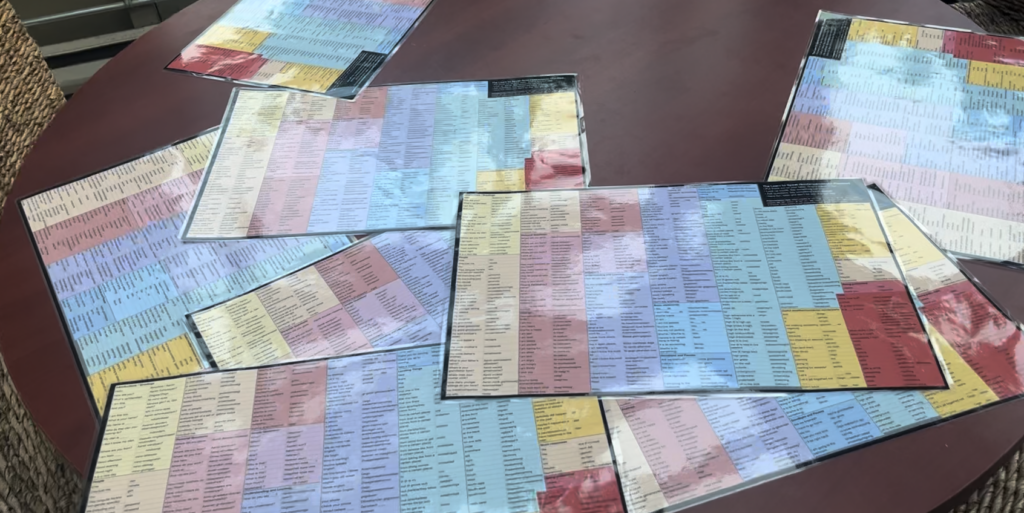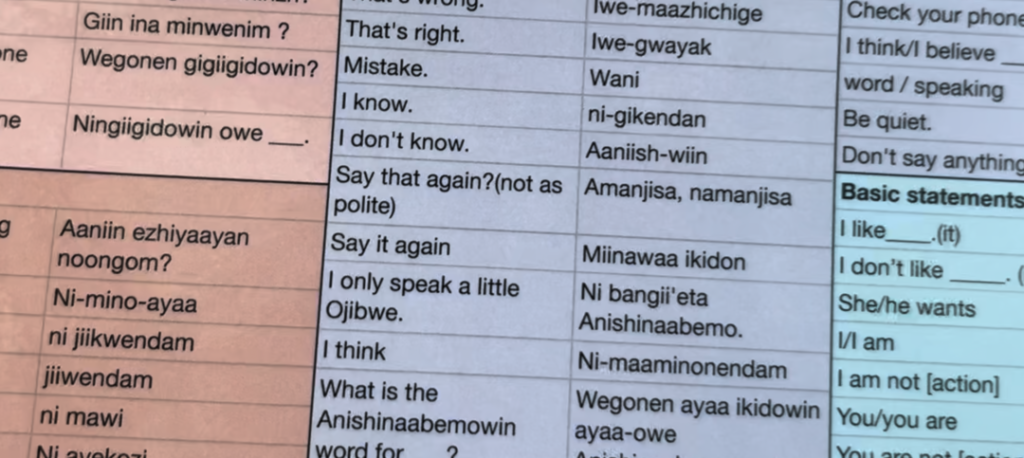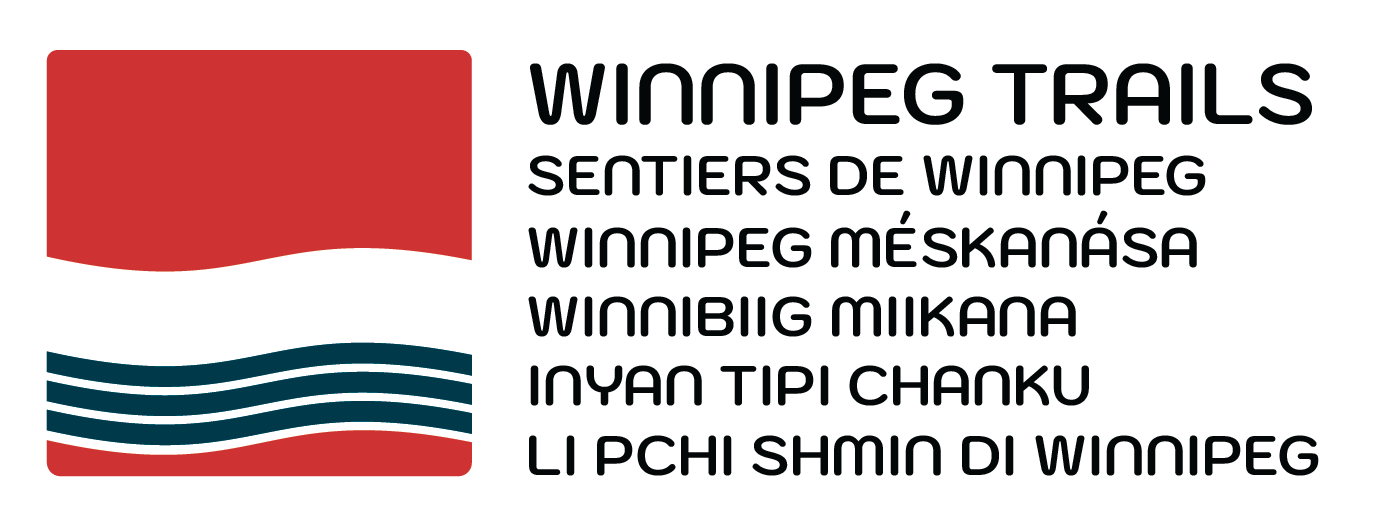
How it Works
The place mat should be (mostly) self-explanatory. Start by skimming the sections by theme, pulling our a word or a sentence here or there that interests you. Find something you wish to say and say it out loud!
Why not keep them on your dining room table? Then you can try it out over breakfast, evening drinks, a game of cards, or colouring with the kids. The colour-coding helps you quickly find relevant words and responses. If your partner doesn’t understand something you say, point to it in the chart! Try pointing to something you see. Make up games. The chart doesn’t cover everything, but it sure covers a lot. When you gain the ability to formulate basic sentences (which is sooner than you think!), try supplementing other words you find online.
Soon, you will soon notice patterns that repeat, making it easier to add one new word at a time; that’s how incremental learning works! We strongly urge people to make use of this resource at home, at school or anywhere with a, well.. table. Repetition really is the best way to learn a language.

Audio
The best audio is the sound of you or your friends voices! And remember, there are as many accents out there as there are people and everyone is “right” as long as they are understood, so try to sound it out. If you want an idea of how others might say this, head over to see the chart on our SpeechTrails.org site where we are adding audio recordings.
Go Here to listen to Audio Recordings
About dialects and the vocabulary on the chart
Put a Newfoundlander or a Scottish person in the same room, and there may be some confusion at first, but ultimately they will understand each other. Ojibwe is no different.
There is more than one way to say something intelligible in any language. Fluent speakers will notice some variance in the terms used here. This is a reflection of the sources. Our little language team, for example, is made up of youth from different areas and with different levels of fluency …from none at all to learning.
In the resources and acknowledgements section below, you’ll note the many sources we use to piece together meanings and come up with this chart. Someone from Sandy Bay or Red Lake may use different words. This is not an exhaustive, perfect word chart. If you would like to contribute a synonym, correction or different way of saying something, we’d love to hear from you. Check out this page on our SpeechTrails website to hear audio and comment!
Get Your Own Set of Place Mats!
You can easily and cheaply get a set of laminated place mats for you and your friends. They can be ordered online or in person from our location at the Forks in Winnipeg. Sales help support the ongoing non-profit work we do related to sustainability and Indigenous culture.
About the Origins of the Place Mat
This learning resource was created in 2024 out of necessity! Why? In the summer of 2024, Winnipeg Trails and its SpeechTrails language team began offering language tables at The Forks – for everyone. Winnipeg Trails is a non-profit organization that cares deeply about creating better space to live, work and play. In Canada, one of the first steps is knowing more about the languages that are (and should be) spoken here.
To run the program, we needed simple tools to help teach, quickly. We produced a number of reference tools and games to make drop-in language learning sessions easier. Some of them entirely our own, and others based on the invaluable work that other people and organizations have been doing in the same space. As the program grew, and became more popular, we wanted one “go to” resource to share with anyone …something to quickly get people talking, and to help orient any newbies – no matter what their skill level. Our Wednesday Wiisinii-daa program – all in Ojibwe only – no English, proved rewarding and challenging.
Trial and error led to the idea of a single, large format, colour coded sheet of paper that could be easily displayed on a table, flipped over when needed, and quickly understood by groups of strangers of varying levels of expertise.
Print Your Own
This resource could not have been possible without the many people who freely share too. That’s why we are happy to encourage others to print their own. We especially urge teachers in Ojibwe/related speaking areas to try integrating this into any context that makes sense – whether its art, geography, or languages. It works for any age and is an important step towards reconciliation.
Here is the source file as of August 2024. Note that these are formatted for 17.25″X11.25″ and intended to be laminated with a menu format sleeve.
Resources and Acknowledgements
This would not be possible without all the encouragement and support from 100s of folks in our community who show up at our events, who do their own language sharing, or who help provide funding.
Specifically we would like to thank Dr.Jon McGavock and CHRIM for believing in a vision however seemingly tangential to their main work. We’d like to thank Joyce Perrault for showing up one day and wanting to share so much. We’d like to thank the late Roger Roulette for being among the first language keepers we so briefly worked with, whose presence we dearly miss – not least of which because he’d probably have a thing or two to say about some of the words we have had to find and use… 😉 Also big thanks to Janell Henry and Brennan McKay – our dynamic language duo – for all the work and relationships they built. Of course Alanna, Lacy, Justin, Mackenzie Shawn, Shyla and the many members of the SpeechTrails language sharing team. Thanks too to the Forks for offering us a place to grow, to MICEC and ILMB for doing such important work. And to people like Pat, Dawnis, and the many knowledge keepers working at home to grow something special. We’re going to miss many folks, so we might as well stop there.
Some resources that helped inform this word chart for you to explore:
- Giga-ganoonidimin Miinawaa! Anishinaabemowin Dictionary from Seven Oaks School Division. Less of a dictionary and more of a concise thematic grouping of words and phrases suitable for lessons, we love the photos. It’s a great class room resource.
- The online People’s Dictionary (Minnesota) So well organized and fast. We use this a lot.
- Basically everything from the MICEC store! There is a special spot in our hearts for the Gidinwewin – Your Language book by Roger Roulette because its a. awesome and b. the first resource that really got us talking to each other. But check out the store, there is something for everyone!
Happy learning!
